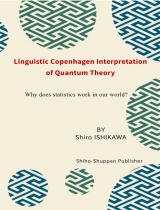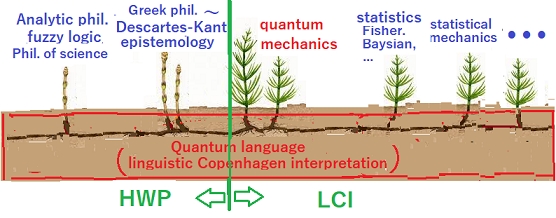LCIQT
Linguistic Copenhagen Interpretation of Quantum Theory
- Why does statistics work in our world? -
by Shiro ISHIKAWA, 365 pages (B5)
paperback: sold at Amazon Stores :
Japan U.S.A. Canada Great Britain
Germany France Spain Italy
ebook (pdf): sold at Google Play : Price $1.00
ISBN:9784907625672(paperback), 9784907625665 (ebook) ,
published on November 15, 2023

Various interpretations of quantum mechanics have been proposed such as the Copenhagen interpretation and the many-worlds interpretation. The linguistic Copenhagen interpretation in this book is a kind of the Copenhagen
interpretation derived from von Neumann's formulation of quantum mechanics on Hilbert spaces.
Von Neumann had the widest coverage of any mathematician of his time, integrating pure and applied sciences and making major contributions to many fields, including mathematics, physics, economics, computing, and statistics. He was not a genius who specialised only in mathematics and physics, but an all-round genius.
From this fact we are tempted to expect the following.
(#1) the quantum theory generated from the linguistic Copenhagen interpretation called Quantum Language(QL) is a very large theory that includes not only quantum mechanics of physics but also classical statistics.
More generally we may say
(#2) QL is the scientific realisation of the dualistic idealism of philosophy.
In this book I devote myself to proving (#1). QL consists of two axioms (measurement and causality) and the linguistic Copenhagen interpretation.
I first prove von Neumann-Lüders projection postulate in QL. This is a solutionin QL, and it is undecided whether it is a physical solution, but the theorem allows
QL to be discussed without being interfered by various paradoxes (e.g., Schrödinger's cat, etc.).
Also, recall that there are no axioms in statistics. This means that we do not yet have 'theoretical statistics'. However, if we consider that QL for classical systems = theoretical statistics, we can then introduce an elegant understanding into statistics. In most books of statistics, Fisher's maximum likelihood method is not given a due treatment. From the quantum linguistic point of view, the most basic arguments are Fisher's maximum likelihood method and regression analysis. They are strongly linked to the measurement and causality axioms, respectively.
As modern statistics continues to develop rapidly in the direction of application now, it is essential to take an overview of statistics as a whole under an umbrella of theoretical statistics.
For (#2), refer to my previous book (i.e., History of Western Philosophy from a perspective of quantum theory :Introduction to theory of everyday science, Shiho-Shuppan Publisher, 425p. (2023)).
Throughout this book as wall as the one above, I assert that von Neumann's formulation of quantum mechanics should not be confined in physics, but should be regarded as a fundamental theory of science.
The targets of the two books (HWP(=Hisory of Western Philosophy ...) and LCI(=Linguistic Copenhagen Interpretation...)) are different from each other as shown in the diagram below, but together they should be considered as one quantum language book.

